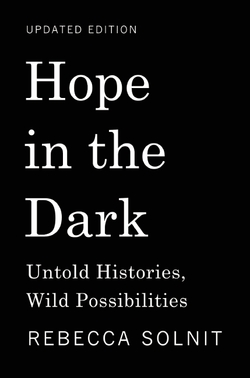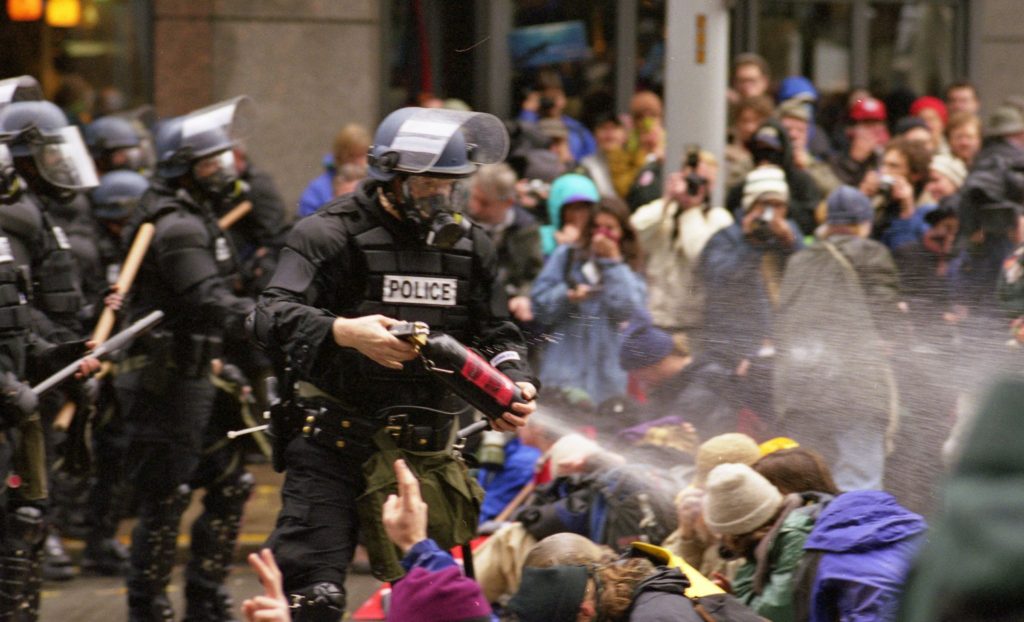Radical Media are books, documentaries, podcasts, zines, and anything else that should be consumed by activists in search of fresh, juicy ideas.
“Things don’t always change for the better, but they change, and we can play a role in that change if we act. Which is where hope comes in, and memory, the collective memory we call history.” — Rebecca Solnit, “Hope In The Dark”

The left has a problem with winning.
We — and while I identify as radical, not leftist, but it’s fair to lump me in with the group for now — are losing bigly, at least from the simplest perspective. A white nationalist regime occupies the White House, while the GOP simultaneously controls most of the country’s legislatures. It’s a dark time, and we’re faced with the prospect of a daily fight just to preserve basic human rights. We need to figure out some way to keep going, despite these losses.
There’s a deeper issue, however, where the Left doesn’t know how to handle victories. Rebecca Solnit’s “Hope In The Dark” from Haymarket Books is meant to be a corrective to Leftist defeatism, offering healthier ways of viewing the arc of history as it haltingly moves toward justice. Originally published in 2004, as Liberal America emerged from the despair of the second Bush administration into the (often misplaced) hope promised by Barack Obama, Solnit updated the book in 2009 and again in 2014.
A victory doesn’t mean that everything is now going to be nice forever and we can therefore all go lounge around until the end of time. — Rebecca Solnit, “Hope In The Dark”
However, this book’s core assertions have only grown more important in light of the Trump regime. After the election,”Hope In The Dark” seemed like such essential reading that Haymarket Books actually gave the book away for free, which is how I picked it up. But you can still get the eBook for about 6 bucks, as of now, and I basically haven’t stopped recommending it to my friends since I started reading it.
Solnit asks us to celebrate every victory, and also to do a better job of remembering them after they’ve passed. Throughout the book, Solnit highlights major inflection points in activist history, and the measurable gains won by determined resistance, many of which we’ve completely forgotten in the progression of new emergencies that have arisen since. She also discourages the left’s tendency to wallow in despair, which often stems out of misplaced fear that celebrating our victories will make people less likely to keep fighting or out of an ego-driven desire to seem more worldly and knowing than other, more hopeful activists. Like in another of her books, “Men Explain Things To Me,” Solnit takes this opportunity to take aim at a few of these patriarchal impulses that hamper effective movement building.

“What we call mushrooms mycologists call the fruiting body of the larger, less visible fungus. Uprisings and revolutions are often considered to be spontaneous, but less visible long-term organizing and groundword — or underground work — often laid the foundation.” — Rebecca Solnit, “Hope In The Dark”
To me, a perfect example of Solnit’s argument about hope can be seen in the recent (temporary) halt to Dakota Access Pipeline construction under Pres. Barack Obama. Immediately as the news broke, armchair activists on social media criticized water protectors for celebrating because they correctly assumed that Pres. Donald Trump would order construction to resume. For many, this means that this transient victory was pointless but, from another perspective the #NoDAPL movement has already won numerous victories. To create the encampments, hundreds of Native American tribes came together in unity, potentially paving the way for future indigenous direct action. And during the hiatus in construction, new anti-pipeline camps have grown in other states, bringing the tactic to new people.
As Kelly Hayes put it for Truthout in December, “eight months of collective action and prayer had yielded this moment, when the power structure itself blinked in the face of our unity.”
Likewise, the Occupy movement didn’t end the influence of money in politics, but the movement trained thousands of new radical activists and won many smaller victories, from the free speech right to use chalk in Florida to the right to assemble without a permit at the Texas Capitol.
Hope is the story of uncertainty, of coming to terms with the risk involved in not knowing what comes next, which is more demanding and, in a way, more frightening. And immeasurably more rewarding. — Rebecca Solnit, “Hope In The Dark”
In essence, Solnit’s argument is that every time we win a little, it sows seeds for the future, even if those seeds are almost immediately buried.
With every day bringing some new setback or bizarre new horror out of government, I’ve found myself turning repeatedly to Solnit’s words for comfort and inspiration. There’s a lot we stand to lose over the next 4 years, and undoubtedly many people will suffer, but our survival and even our success depends on cultivating hope wherever we can fertile ground to grow it.
 Rebecca Solnit’s ‘Hope In The Dark’ Is An Antidote To Leftist Doom & Gloom by Kit O’Connell is licensed under a Creative Commons Attribution 4.0 International License.
Rebecca Solnit’s ‘Hope In The Dark’ Is An Antidote To Leftist Doom & Gloom by Kit O’Connell is licensed under a Creative Commons Attribution 4.0 International License.
Based on a work at https://kitoconnell.com/2017/02/17/mini-review-hope-dark-rebecca-solnit.
